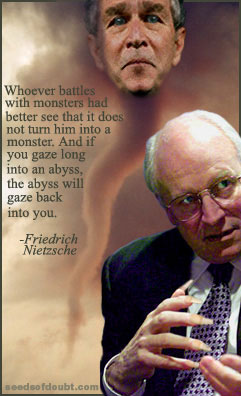Sen. John Kerry says a key reason that the Democratic political message seems so muddled to many Americans is that Democrats have a smaller “megaphone” than the one wielded by the Republicans and their conservative allies.
“Our megaphone is just not as large as their megaphone, and we have a harder time getting that message out, even when people are on the same page,” the Massachusetts Democrat explained to the New York Times for a story about the party’s missed opportunities heading toward Election 2006. [NYT, Feb. 8, 2006]
While Kerry’s observation is undeniably correct – when one considers Fox News, right-wing talk radio, well-paid columnists and magazine racks weighted down by conservative publications – the overarching question remains why Democrats and progressives haven’t invested more in getting a competitive megaphone.
Wealthy progressives and liberal foundations can match up almost dollar for dollar with conservative funders. But the American Left has adopted largely a laissez-faire attitude toward media infrastructure, while the Right has applied almost socialistic values to sustain even unprofitable media ventures.
Indeed, the Right’s subsidizing of media may be the most under-reported money-in-politics story in modern American history. Many good-government organizations track the millions of dollars contributed to candidates, but much less attention is paid to the billions of unregulated dollars poured into media.
This imbalanced attention continues even though the conservative media is arguably the most important weapon in the Republican arsenal.
Political “propaganda themes” – often coordinated with GOP leaders – are distributed instantaneously across the country, reaching into both rural and urban America with a repetition that gives these messages a corroborative ring of truth.
The messages echo from talk radio to cable news to conservative columnists who appear in the mostly pro-Republican local newspapers. The themes then are reinforced in magazine articles and in books that dominate the shelves of many American bookstores.
Over the past two decades, Republicans have exploited this media capability with great deftness in consolidating power across large swaths of the country, especially where there is little media diversity (i.e. the Red States).
Key Moments
The Right’s megaphone is particularly decisive at key moments when power is being conveyed – that is, before national elections, when a Supreme Court nominee is facing confirmation, or when the nation is poised to go to war. But it’s also there when conservatives are working to consolidate their base or just rile up the true-believers.
So, for instance, when the Senate was weighing the nomination of Supreme Court nominee Samuel Alito, the right-wing news media – and much of the mainstream press – spent more time chastising Democrats for supposedly making Mrs. Alito cry than they did explaining Alito’s radical theories of the “unitary executive.”
Sen. Robert Byrd, D-W.Va., who often speaks eloquently about the constitutional checks and balances that are under assault from Alito’s theories, said he was swayed to vote for Alito because so many West Virginians called to complain that the Democrats had been mean to him during the confirmation hearings.
It’s doubtful, of course, that many West Virginians actually watched the Alito hearings on television. But they surely heard the spin given to the hearings on right-wing radio stations as they drove to and from work.
Similarly, the right-wing media helped feed the war fever that swept the United States in late 2002 and early 2003.
Anyone who questioned George W. Bush’s case for war with Iraq was pilloried as un-American. Celebrities, such as the Dixie Chicks and Sean Penn, were held up to ridicule. Former weapons inspector Scott Ritter, who doubted the existence of Iraq’s weapons of mass destruction, was called a traitor.
Not surprisingly, most Democrats and much of the mainstream news media quickly fell into line. Often, it was difficult to distinguish between the pro-war coverage on Fox and the pro-war coverage on MSNBC and CNN, as those two cable networks scrambled to “Out-Fox Fox.” [See Consortiumnews.com’s “Bay of Pigs Meets Black Hawk Down.”]
On other occasions, the Right ties its themes to the calendar, such as the ballyhooed “War on Christmas” that roiled the chat shows in December and was cross-marketed with a book by Fox News anchor John Gibson, The War on Christmas: How the Liberal Plot to Ban the Sacred Christian Holiday Is Worse Than You Thought.
( If we had a bigger microphone, we could say: "It is the commercialization of Christmas, by money-sucking, corporate crack-whores, that has robbed it of sacredness, if anything has. Christmas, is a sacred as one wants to make it. Getting on television and stirring up more hatred among the religiously insane and the ignorant is not helping Christmas be sacred.)
As absurd as it might be to think that the United States doesn’t adequately honor Christmas – when the lavish celebration lasts for a month – the “war on Christmas” theme agitated Christians with the notion that they’ve become the victims of secularists, Jews and other non-Christians. [For details, see Consortiumnews.com’s “The Meaning of (the War Over) Christmas.”]
In essence, the right-wing media – a vertically integrated machine reaching from books, magazines and newspapers to radio, television and the Internet – has the power to make almost any ludicrous notion seem real and threatening to millions of Americans.







No comments:
Post a Comment